For new construction applications machinery such as mini-excavators, standard excavators, backhoes, and skid steer loaders are typically used to install helical piles. In special circumstances where access is limited, portable installation equipment may be utilized.
The three functions of the machine in helical pile installation are:
Weight: Since weight is required to resist the torque applied to a helical pile, the installation machine first serves as the foundation for installation.
Hydraulics: Secondly, the machine’s hydraulic pump serves as the hydraulic supply to the torque motor. Properly matched hydraulic pressure and flow between the machine and torque motor are critical for an efficient installation.
Movement: Lastly, the machine is used to manipulate, align, and locate the installation of a helical pile. Mobility and/or articulation of the boom greatly improves ease of installation.
Note that a machine is only as good as the operator running the piece of equipment. Properly trained operators with previous helical pile installation experience greatly increases productivity and reduces installation issues.
Mini-Excavators
Mini-excavators are a popular choice for new construction helical pile installations when the torque required is less than 15,000 ft-lbs.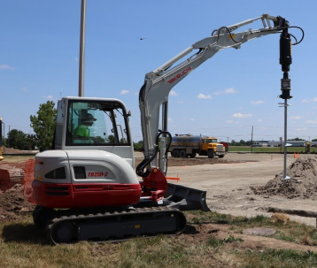
Advantages include:
- Low mobilization costs - most machines can be transported on a 20 to 24 ft long equipment trailer.
- Metal or rubber tracks decrease ground pressures. “No mark” rubber tire tracks are also available for installation in the interior of warehouses and other structures with concrete floors.
- Joystick-controlled booms offer superior control. Older “wobble stick” or “push lever” boom controls can be utilized but will require a more skilled and seasoned operator.
- Versatility - mini-excavators can be fitted for either helical pile dedicated installation or with boom adapters that allow for quick change adaptation to a bucket for excavation.
- Small footprint - can be maneuvered into tighter spaces than larger excavators or backhoes.
Disadvantages of a mini-excavator are the limited torque capacity and boom height due to their smaller size. This can be an issue when installing longer piles sections or higher capacity piles. Pressure regulation can be an issue with new machines since digging requires a maximum of 2500 psi. Therefore, pressure regulators can be set at lower pressures than what is required for maximum torque capacity of a torque motor. This can lead to lower torque output than previously assumed due to inadequate hydraulic pressure.
When using rental equipment, it is recommended that a contractor confirm that the pressure regulator will be set at pressures that are adequate for the hydraulic motor. Some rental companies may be unwilling to adjust pressures greater than a specific predetermined level. Lastly, it is typical to connect torque motors to an auxiliary hydraulic circuit. Please confirm with the manufacturer or rental company that the auxiliary hydraulic circuit is bi-directional. Older domestically made machines and new machines outside of the United States and Canada may still have one-way hydraulic circuits. A one-way circuit will not allow hydraulic flow direction to be changed which means the torque motor will rotate in only one direction.
Standard Excavators
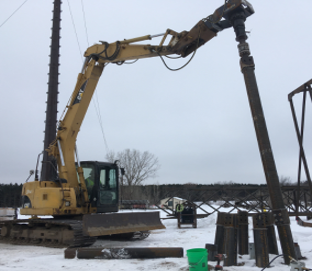 Standard excavators are a popular choice for new construction helical installations when installation torque required is more than 20,000 ft-lbs. They are a good choice for round shaft helical piles, since pipe piles will typically require greater down pressure, also known as pile crowd. Like mini-excavators, low ground pressures can be achieved with the machine's tracks. Longer boom lengths allow for a higher boom height that can facilitate much larger pile sections. Larger excavators are capable of installation of sections up to 15 feet or longer.
Standard excavators are a popular choice for new construction helical installations when installation torque required is more than 20,000 ft-lbs. They are a good choice for round shaft helical piles, since pipe piles will typically require greater down pressure, also known as pile crowd. Like mini-excavators, low ground pressures can be achieved with the machine's tracks. Longer boom lengths allow for a higher boom height that can facilitate much larger pile sections. Larger excavators are capable of installation of sections up to 15 feet or longer.
Due to their size and weight, mobilization costs are typically higher. Standard excavators usually will require a flatbed, or a “low boy” trailer pulled by a semi-truck. Similar issues can occur with pressure regulators and one-way auxiliary hydraulic circuits as discussed with mini-excavators. Good site access is typically required as well as a skilled machine operator.
Backhoes
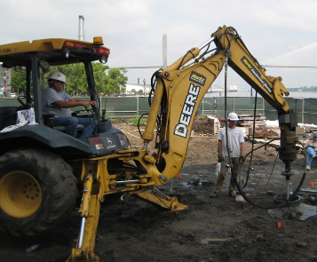 Backhoes are one of the most common types of equipment used in the construction industry. They are found on most construction sites and are a highly versatile piece of equipment. A backhoe’s boom has similar reach and height to that of a mini-excavator and will install comparable sized helical piles.
Backhoes are one of the most common types of equipment used in the construction industry. They are found on most construction sites and are a highly versatile piece of equipment. A backhoe’s boom has similar reach and height to that of a mini-excavator and will install comparable sized helical piles.
One disadvantage of a backhoe is its larger size and rubber tires. Backhoes have a larger footprint and typically weigh more than a mini excavator and therefore will require good site access. Higher ground pressures due to the rubber tires limits its usefulness on soft ground. Backhoes are a great option for contractors who need a versatile piece of equipment on a site. Backhoes are not typically used for dedicated helical pile installation. More commonly, they are used to install as required then refitted to excavate or move material elsewhere on the site. Backhoes are a popular choice for new helical pile contractors who wish to add helical pile installation to an existing line of construction services.
Skid Steer Loaders
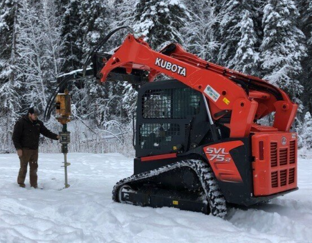 Skid steer loaders are a popular choice for highly constrained or limited access sites. Their small stature is well suited for the tightest areas within alleys, buildings, and restricted access sites. Tracked skid loaders are a great choice in areas where low ground pressures are required such as environmentally sensitive areas or marshes. Their small stature and limited boom height does limit their versatility to helical pile section lengths less than 7 feet long. Their light weight effectively limits the torque motor capacity to 7,000 ft-lbs. Angled or battered installations can be difficult and vertical installations are typically recommended.
Skid steer loaders are a popular choice for highly constrained or limited access sites. Their small stature is well suited for the tightest areas within alleys, buildings, and restricted access sites. Tracked skid loaders are a great choice in areas where low ground pressures are required such as environmentally sensitive areas or marshes. Their small stature and limited boom height does limit their versatility to helical pile section lengths less than 7 feet long. Their light weight effectively limits the torque motor capacity to 7,000 ft-lbs. Angled or battered installations can be difficult and vertical installations are typically recommended.
No matter which type of machine you use, proper care and maintenance are of utmost importance. Learn more about machine maintenance for helical pile installers. Your Chance local distributor can help you select the proper machinery for helical pile installation.
Find your local distributor to learn more about machine selection, tooling, product pricing and more.

Need training on how to properly install helical piles? Inquire about becoming a Chance Certified Installer.

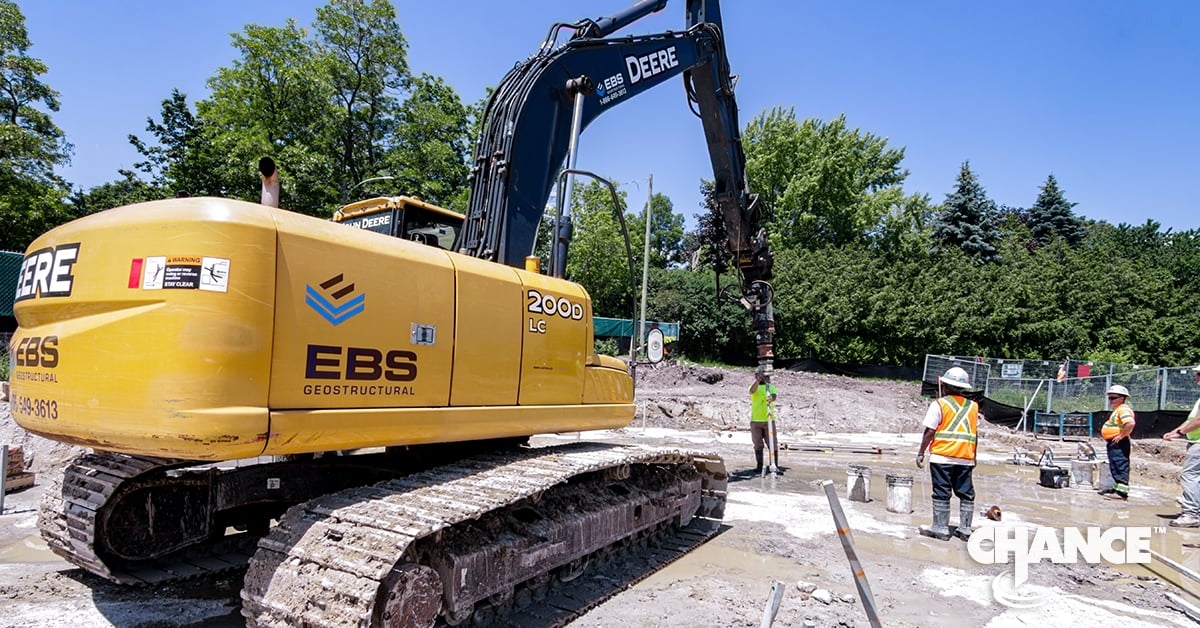

 Standard excavators are a popular choice for new construction helical installations when installation torque required is more than 20,000 ft-lbs. They are a good choice for round shaft helical piles, since pipe piles will typically require greater down pressure, also known as pile crowd. Like mini-excavators, low ground pressures can be achieved with the machine's tracks. Longer boom lengths allow for a higher boom height that can facilitate much larger pile sections. Larger excavators are capable of installation of sections up to 15 feet or longer.
Standard excavators are a popular choice for new construction helical installations when installation torque required is more than 20,000 ft-lbs. They are a good choice for round shaft helical piles, since pipe piles will typically require greater down pressure, also known as pile crowd. Like mini-excavators, low ground pressures can be achieved with the machine's tracks. Longer boom lengths allow for a higher boom height that can facilitate much larger pile sections. Larger excavators are capable of installation of sections up to 15 feet or longer. Backhoes are one of the most common types of equipment used in the construction industry. They are found on most construction sites and are a highly versatile piece of equipment. A backhoe’s boom has similar reach and height to that of a mini-excavator and will install comparable sized helical piles.
Backhoes are one of the most common types of equipment used in the construction industry. They are found on most construction sites and are a highly versatile piece of equipment. A backhoe’s boom has similar reach and height to that of a mini-excavator and will install comparable sized helical piles. Skid steer loaders are a popular choice for highly constrained or limited access sites. Their small stature is well suited for the tightest areas within alleys, buildings, and restricted access sites. Tracked skid loaders are a great choice in areas where low ground pressures are required such as environmentally sensitive areas or marshes. Their small stature and limited boom height does limit their versatility to helical pile section lengths less than 7 feet long. Their light weight effectively limits the torque motor capacity to 7,000 ft-lbs. Angled or battered installations can be difficult and vertical installations are typically recommended.
Skid steer loaders are a popular choice for highly constrained or limited access sites. Their small stature is well suited for the tightest areas within alleys, buildings, and restricted access sites. Tracked skid loaders are a great choice in areas where low ground pressures are required such as environmentally sensitive areas or marshes. Their small stature and limited boom height does limit their versatility to helical pile section lengths less than 7 feet long. Their light weight effectively limits the torque motor capacity to 7,000 ft-lbs. Angled or battered installations can be difficult and vertical installations are typically recommended.



